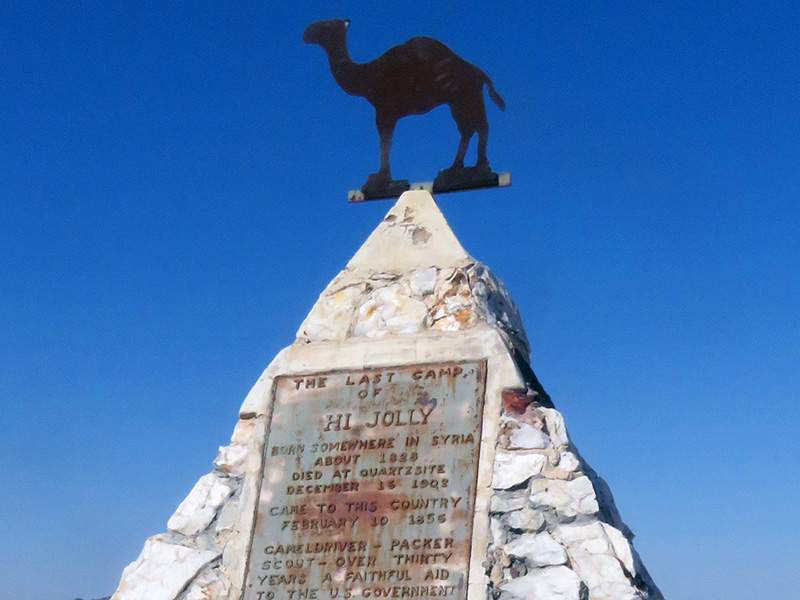|
|
23. The Beasts of Tejon
|
The men of Company A, First United States Dragoons, were tired, dusty and bedraggled after a two-month march across the searing desert. Under the command of First Lieutenant Thomas F. Castor, they were invigorated by the cool breezes that met them when they finally reached the 4,500-foot high precipice of Grapevine Pass on August 10, 1854. Lieutenant Castor wasted no time in laying out barracks, officers' quarters, storehouses and parade grounds at Fort Tejon. The founding was not without some element of mystery, for carved into an oak was the inscription, "Peter LaBeck, killed by an X bear, Oct. 17, 1837." Little is known about Peter LaBeck other than that he was a trapper; no one knows who cut the marker into the tree. The military post was established to stop cattle rustling and to protect the Indians, and became the western terminus of a supply route using camels. Largely forgotten now, the saga of the Camel Corps is an interesting chronicle. While exploring Death Valley with Kit Carson, Lieutenant Edward F. Beale got the idea of using camels in the trackless Southwest and suggested it to Secretary of War Jefferson Davis. The secretary was toying with the notion of a line of relay balloons at the time, so camels did not sound so preposterous. Colonel David D. Porter was dispatched to Egypt and Arabia with thirty thousand dollars to buy the beasts. On May 13, 1856, Porter landed at Indianola, Texas, with the first contingent of thirty-three; another forty-four followed. Some were sent to San Antonio, while twenty-five set out for the Colorado River, commanded by Beale, who was by this time a colonel. A couple of experienced camel drivers came from Arabia: Hadji Ali (the soldiers quickly changed his name to "Hi Jolly") and a fellow known as "Greek" George Allen. The Los Angeles Star reported on January 27, 1858 that "Colonel Beale and about fourteen camels stalked into town last Friday week and gave our streets quite an Oriental aspect." In a letter to the Secretary of War, Beale was lavish in his praise:
While Beale was enthusiastic, no one else seemed to be. The troopers learned, to their dismay, that camels could inflict nasty bites, spit with deadly accuracy, and be far more cantankerous that a Missouri mule. Horses and cows panicked at the sight and smell of the ungainly beasts, while their roar — likened to that of a Bengal tiger — kept man and animal awake half the night. With the outbreak of the Civil War in 1861, supply lines across the Southwest were cut by the Confederacy, and the Camel Corps was put to pasture. They were used locally between Tejon and Los Angeles until the fort was abandoned on September 11, 1864. Some were sold to zoos, others were turned loose in the mountains. The last auction of camels was held at Camp Verde in 1866. For years afterward, there were rumors of camels wandering the Tehachapis or drinking deeply from the banks of the Santa Clara. The final, sad act of the drama occurred on December 16, 1902, when seventy-four-year-old Hi Jolly was sitting in a saloon at Quartzsite, Arizona. A prospector stumbled in, telling of a huge, red camel wandering nearby. Jolly rushed outside and was never seen alive again. According to local legend, his withered body was found weeks later in the remote desert. There he lay with lifeless arms wrapped around the neck of the last camel in the West. ©1998 SANTA CLARITA VALLEY HISTORICAL SOCIETY RIGHTS RESERVED. |
SCV History Moment
Hi Jolly Song
Hi Jolly's Tomb 2002
Hi Jolly's Tomb 2018
Hi Jolly Pioneer Cemetery Guide
Trek Map
1935 "Revival"
1858 Story
Story 1940s
E.F. Beale & the Beasts of Tejon
Fort Tejon Camels by Vischer
Loading Camels ~1857
Fort Davis TX
Maverick Comic 1958
|
The site owner makes no assertions as to ownership of any original copyrights to digitized images. However, these images are intended for Personal or Research use only. Any other kind of use, including but not limited to commercial or scholarly publication in any medium or format, public exhibition, or use online or in a web site, may be subject to additional restrictions including but not limited to the copyrights held by parties other than the site owner. USERS ARE SOLELY RESPONSIBLE for determining the existence of such rights and for obtaining any permissions and/or paying associated fees necessary for the proposed use.













